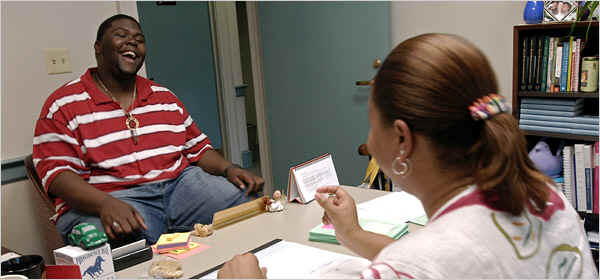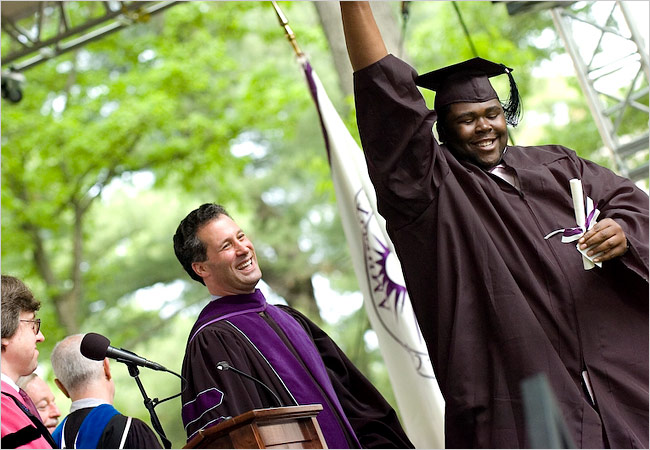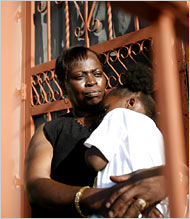| Want to send this page or a link to a friend? Click on mail at the top of this window. |
More Special Reports |
| Posted May 27, 2007 |
| Elite Colleges Open New Door to Low-Income Youths |
 |
|
Nancy palmieri for The New York Times |
|
| Tony Jack and his supervisor, Dmisha W. Lee, in the admission office, where Mr. Jack has a work-study job. | |
By SARA RAIMER |
AMHERST, Mass. — The discussion in the States of Poverty seminar here at Amherst College was getting a little theoretical. Then Anthony Abraham Jack, a junior from Miami, asked pointedly, “Has anyone here ever actually seen a food stamp?”
To Mr. Jack, unlike many of his classmates, food stamps are not an abstraction. His family has had to use them in emergencies. His mother raised three children as a single parent and earns $26,000 a year as a school security guard. That is just a little more than half the cost of a year’s tuition, room and board, fees and other expenses at Amherst, which for Mr. Jack’s class was close to $48,000.
So when Mr. Jack, now 22 and a senior, graduated with honors here on Sunday, he was not just the first in his family to earn a college degree, but a success story in the effort by Amherst and a growing number of elite colleges to open their doors to talented low-income students.
Concerned that the barriers to elite institutions are being increasingly drawn along class lines, and wanting to maintain some role as engines of social mobility, about two dozen schools — Amherst, Harvard, Princeton, Stanford, the University of Virginia, Williams and the University of North Carolina, among them — have pushed in the past few years to diversify economically.
They are trying tactics like replacing loans with grants and curtailing early admission, which favors the well-to-do and savvy. But most important, Amherst, for instance, is doing more than giving money to low-income students; it is recruiting them and taking their socioeconomic background — defined by family income, parents’ education and occupation level — into account when making admissions decisions.
 |
Charles Quigg/Amherst College Public Affairs |
| Tony Jack receiving his Amherst college diploma on Sunday |
Amherst’s president, Anthony Marx, turns to stark numbers in a 2004 study by the Century Foundation, a policy institute in New York, to explain the effort: Three-quarters of students at top colleges come from the top socioeconomic quartile, with only one-tenth from the poorer half and 3 percent from the bottom quartile.
“We want talent from across all divides, wherever we can find it,” President Marx said. Amherst covered the full cost of Mr. Jack’s education beyond what he earned in work-study. The only debt he says he owes is the $41 it cost to make copies of his 107-page honors thesis.
Amherst also provides its low-income students important support, from $400 “start-up grants” for winter coats and sheets and blankets for their dorm rooms, to summer science and math tutoring. At the same time, low-income students are expected to put in at least seven hours a week at $8-an-hour work-study jobs.
But they get to use $200 a month in their work-study earnings as spending money to get a haircut, for instance, or go out for pizza with classmates so they don’t feel excluded.
Mr. Jack, who is black and had never been on a plane until he flew to Amherst for his first visit, arrived as an A student, and with a steely focus.
His mother, Marilyn, 53, had guided her son from Head Start to a gifted program in elementary school to a magnet middle school and, in his final year of high school, to the private Gulliver Preparatory School on a full scholarship. But she never had to push Tony, she said. “He was on a mission from Day 1,” she said.
Mr. Jack’s high grades and test scores — a respectable 1200 on the SAT — won him a full scholarship to the University of Florida. But the median score for his Amherst class was 1422, and he would have been excluded had the admissions office not considered his socioeconomic class, and the obstacles he had overcome.
 |
| Barbara P. Fernandez for The New York Times |
| Marilyn Jack, Tony's mother, with her granddaughter, Makala. |
“Tony Jack with his pure intelligence — had he been raised in Greenwich, he would have been a 1500 kid,” said Tom Parker, the dean of admission. “He would have been tutored by Kaplan or Princeton Review. He would have had The New Yorker magazine on the coffee table.”
“Tony Jack is not an anomaly,” he added.
Mr. Jack, Amherst officials say, would likely not have benefited under traditional affirmative action programs. In their groundbreaking 1998 study of 28 selective universities, William Bowen, the former president of Princeton, and Derek Bok, now the interim president of Harvard, found that 86 percent of blacks who enrolled were middle or upper middle class. (Amherst was not included in that study.) The white students were even wealthier.
“Universities have prided themselves on making strides in racial diversity, but for the most part they have avoided the larger issue of class inequality,” said Richard D. Kahlenberg, a senior fellow at the Century Foundation.
For Mr. Jack, there were adjustments at this college, where half the students are affluent enough that their parents pay tuition without any aid from Amherst.
He did not let it bother him, he said, when wealthier classmates blithely inquired about the best clubs in Miami — as if he would know, Mr. Jack said dryly — before flying off to his hometown for spring break. Mr. Jack could afford to go home only at Christmas, and the end of the year, when Amherst paid his plane fare.
Mr. Jack is 6 foot 7 and built like the football player he used to be. In his freshman year, he said, he was walking to his dorm one night when a police car seemed to be following him. He recalled showing the officer his Amherst ID and explaining, “I’m a student here.”
In Mr. Jack’s class of 413, 15 percent, or 61, students, are from families with incomes of less than $45,000 a year; about two-thirds of those are from families earning less than $30,000. He was amazed to discover how much preparation wealthier students had.
“People are groomed for the SAT,” Mr. Jack said. “They take Latin to help them with their vocabulary.”
He seized every opportunity Amherst offered — the pre-freshman summer program in science and math, help from the writing center and faculty office hours. “They didn’t just invite me in,” he said. “They prepared the way.”
For his freshman year, he chose the most challenging classes, including Chemical Principles, even though he had no chemistry in high school. “I didn’t feel like I was in over my head,” he said. “I just felt like I was being pushed to the boundaries of my ability.”
He got all A’s and B’s his first year, except for a C-plus in chemistry. Sophomore year he plunged in even deeper, taking Organic Chemistry I and II. He got a B the first semester, and an A-minus the second.
“Organic chemistry was the happiest time of my life,” said Mr. Jack, who tends to gush about Amherst. “Everything started clicking.”
David Hansen, who taught Organic Chemistry II, called Mr. Jack’s improvement remarkable: “He had the motivation and the desire and the discipline to take advantage of the support that was here.”
Mr. Jack, who is as gregarious as he is studious, found time to mentor other students, serve on committees — and earn an A-plus in calculus last year, one of only 10 A-pluses the professor, David Cox, said he has given out in calculus in 30 years of teaching. This year Mr. Jack was Amherst’s nominee to be a Rhodes scholar at Oxford.
Squeamish about blood, Mr. Jack switched his major from pre-med to religion and gender studies. He said he intended to go to graduate school. For now, he loves Amherst so much, he is staying around as an “alumni fellow,” organizing events on campus. He says he thinks about teaching, or becoming a lawyer so that he can help his community. As for money, he says he just wants to be able to take care of his family.
At Amherst’s commencement on Sunday, Mr. Jack wept — and his classmates gave him a standing ovation — when President Marx awarded him the annual prize for the senior who has “shown by his or her own determination and accomplishment the greatest appreciation of and desire for a college education.”
Thanks to Amherst, Mr. Jack said, he has rewritten the narrative of his life. It isn’t about “a poor black student” going “from the bottom to the top,” as he once believed, he wrote in an essay about his family and all they have done for him. His mother, his older brother, his younger sister and his two nieces were here at graduation, having driven up in a rented van from Miami.
“Being a senior at Amherst is only one step along my journey through life,” he wrote. “You want to know Anthony Abraham Jack, then look behind the man you see walking around campus today. And you, in doing so, surely will never say that he came from the bottom and is now at the top.”
Copyright 2007 The New York Times Company. Reprinted from The New York Times, National, of Sunday, May 27, 2007.
| Wehaitians.com, the scholarly journal of democracy and human rights |
| More from wehaitians.com |